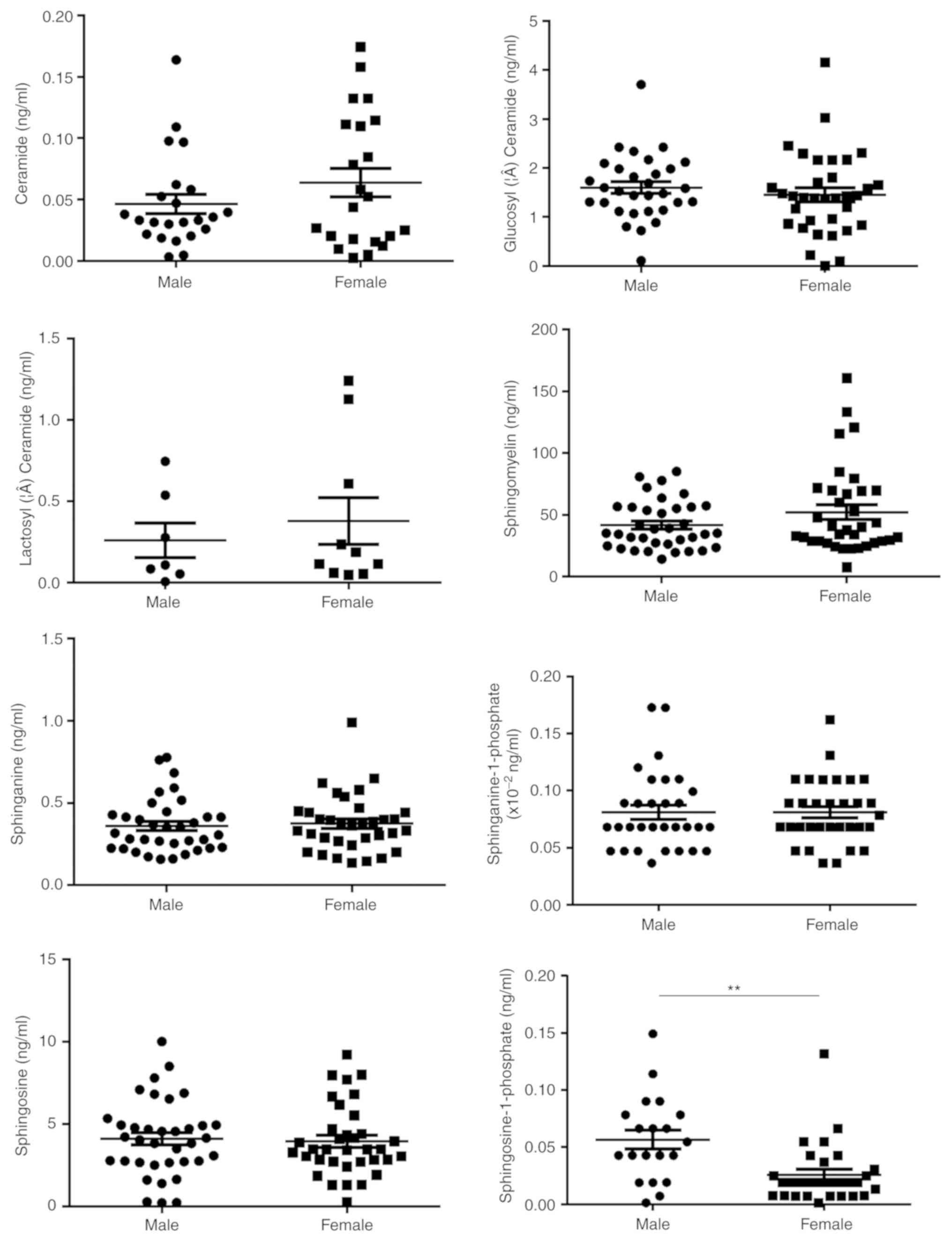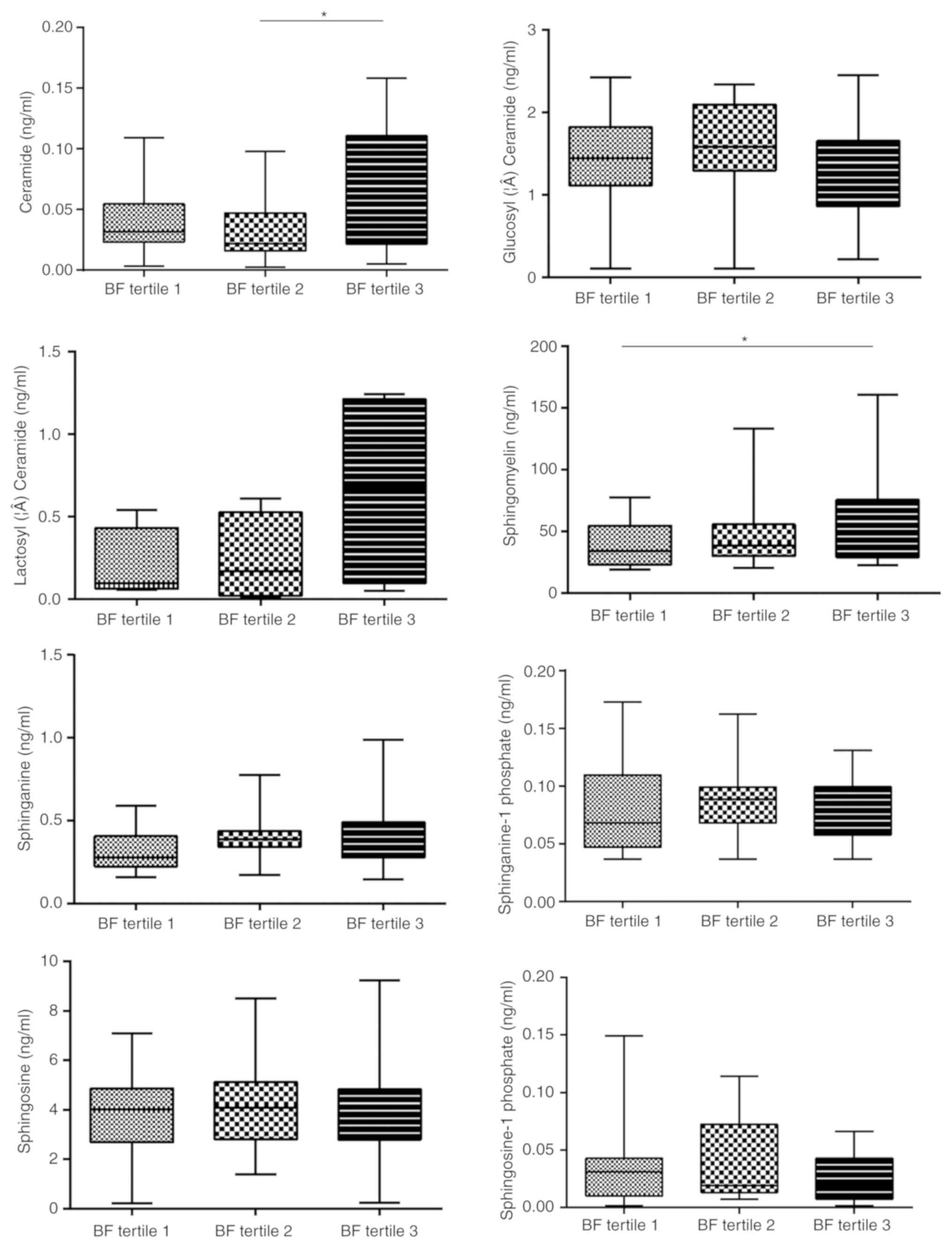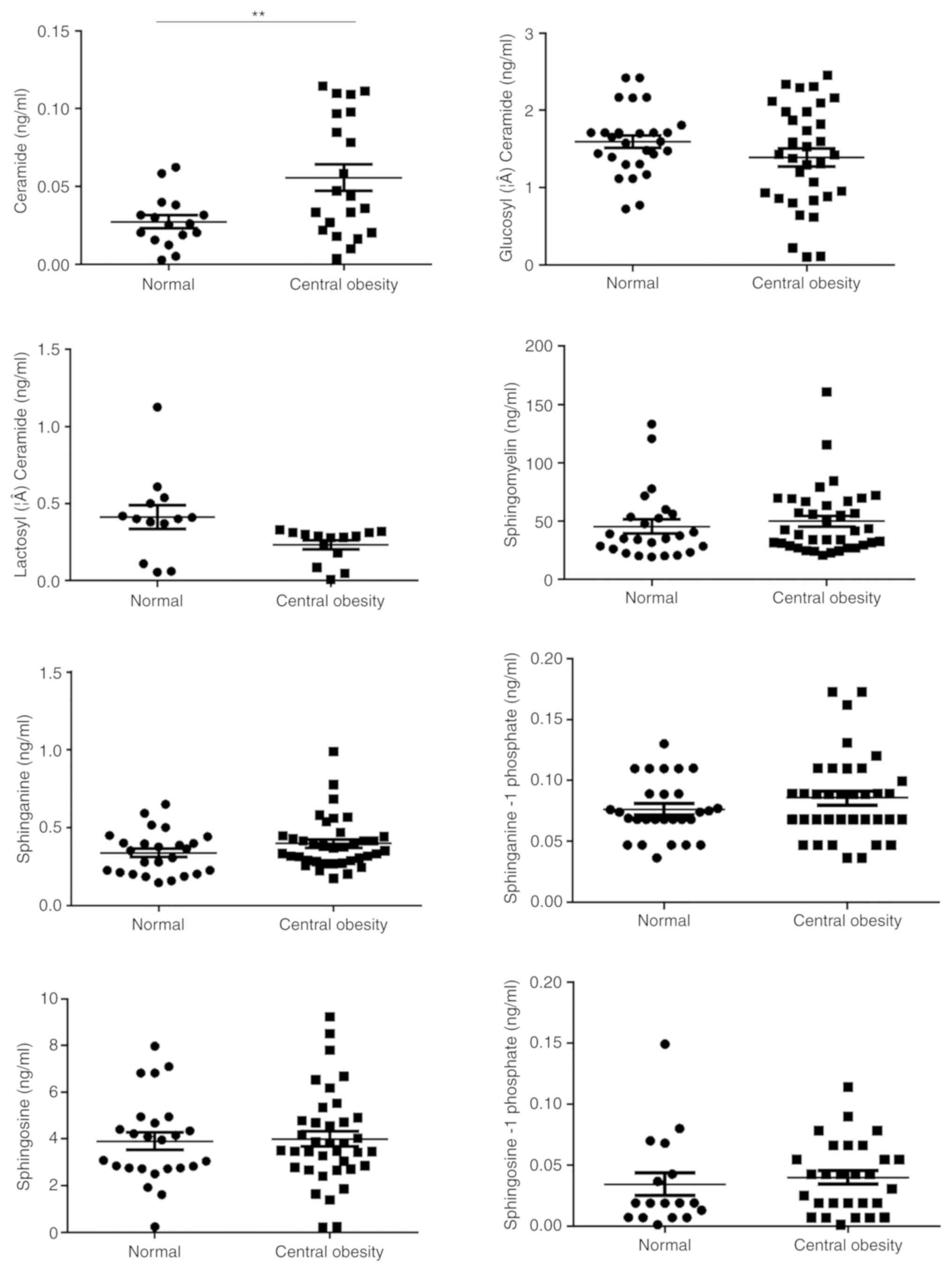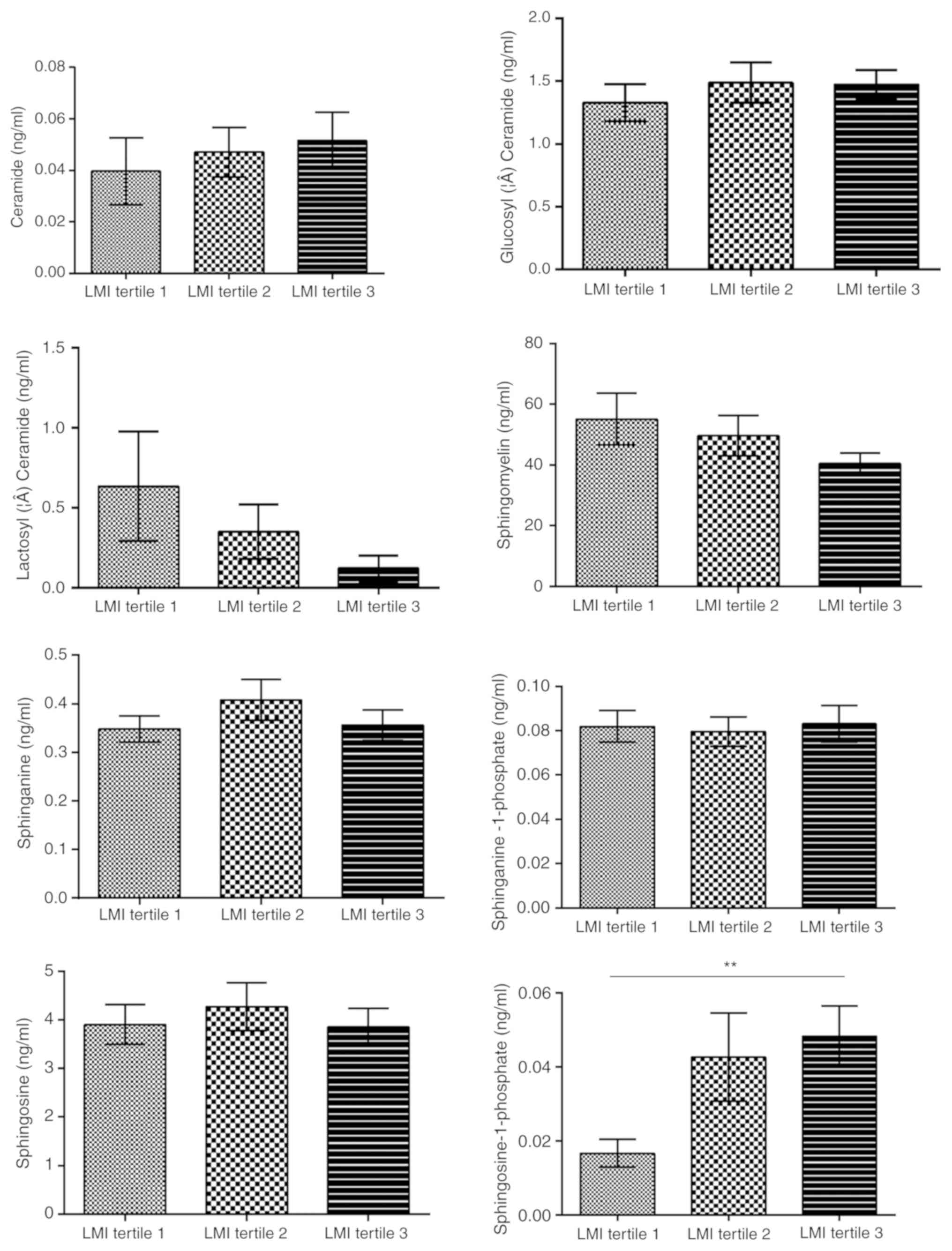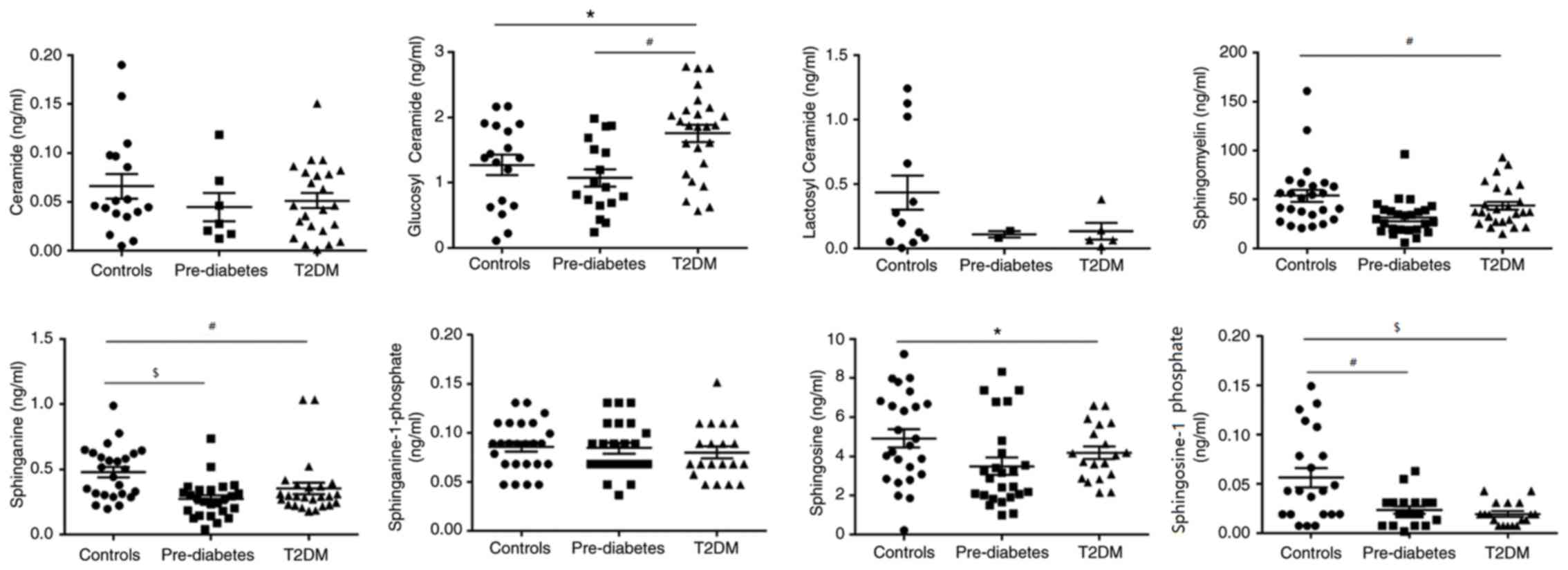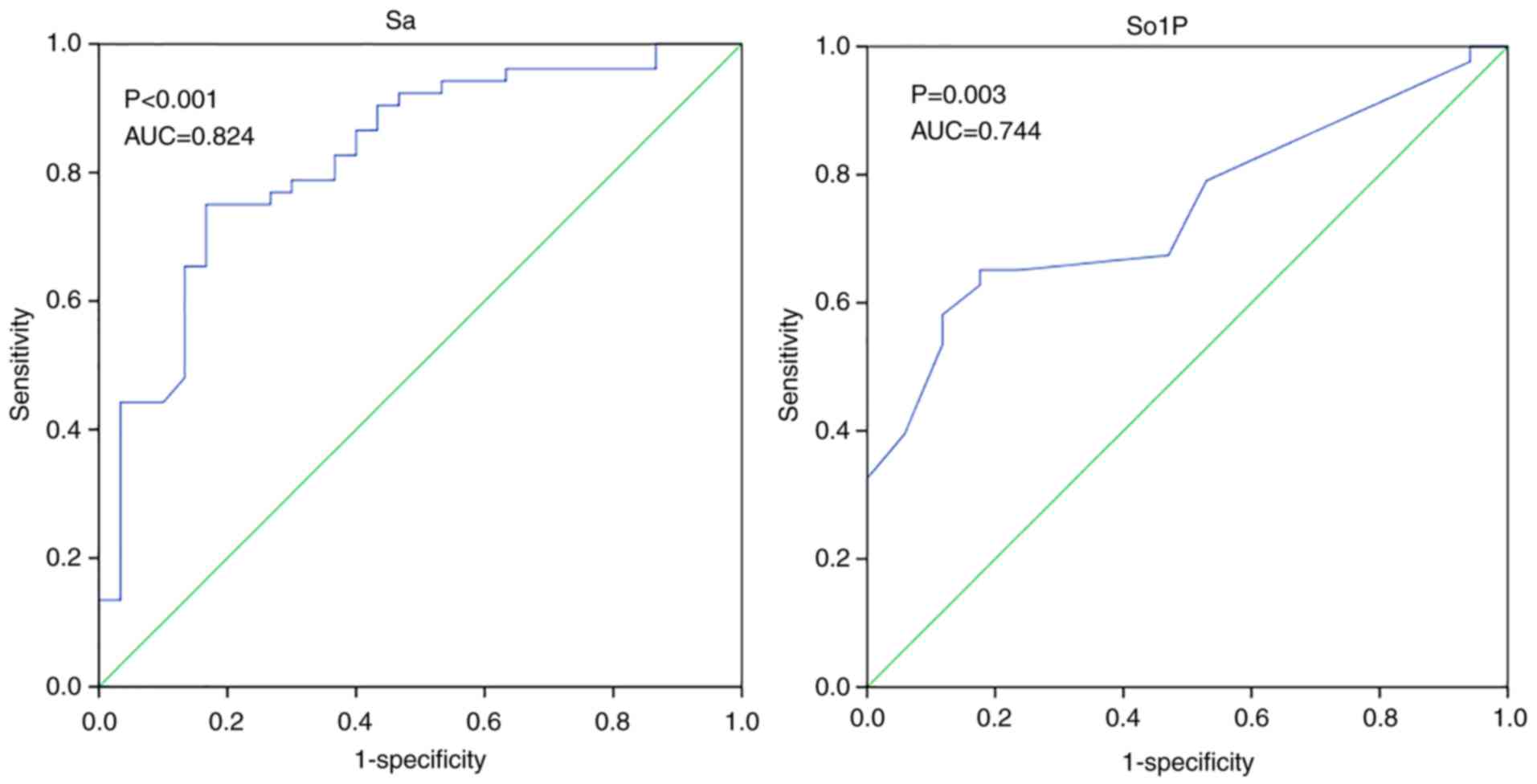|
1
|
Mathers CD and Loncar D: Projections of
global mortality and burden of disease from 2002 to 2030. PLoS Med.
3:e4422006. View Article : Google Scholar : PubMed/NCBI
|
|
2
|
Wong ND: Epidemiological studies of CHD
and the evolution of preventive cardiology. Nat Rev Cardiol.
11:276–289. 2014. View Article : Google Scholar : PubMed/NCBI
|
|
3
|
American Diabetes Association: 10.
Cardiovascular disease and risk management: Standards of Medical
Care in Diabete-2019. Diabetes Care. 42 (Suppl 1):S103–S123. 2019.
View Article : Google Scholar : PubMed/NCBI
|
|
4
|
Tonks KT, Coster AC, Christopher MJ,
Chaudhuri R, Xu A, Gagnon-Bartsch J, Chisholm DJ, James DE, Meikle
PJ, Greenfield JR and Samocha-Bonet D: Skeletal muscle and plasma
lipidomic signatures of insulin resistance and overweight/obesity
in humans. Obesity (Silver Spring). 24:908–916. 2016. View Article : Google Scholar : PubMed/NCBI
|
|
5
|
Chaurasia B, Kaddai VA, Lancaster GI,
Henstridge DC, Sriram S, Galam DL, Gopalan V, Prakash KN, Velan SS,
Bulchand S, et al: Adipocyte ceramides regulate subcutaneous
adipose browning, inflammation, and metabolism. Cell Metab.
24:820–834. 2016. View Article : Google Scholar : PubMed/NCBI
|
|
6
|
Meikle PJ and Summers SA: Sphingolipids
and phospholipids in insulin resistance and related metabolic
disorders. Nat Rev Endocrinol. 13:79–91. 2017. View Article : Google Scholar : PubMed/NCBI
|
|
7
|
Samad F, Badeanlou L, Shah C and Yang G:
Adipose tissue and ceramide biosynthesis in the pathogenesis of
obesity. Adv Exp Med Biol. 721:67–86. 2011. View Article : Google Scholar : PubMed/NCBI
|
|
8
|
Holland WL, Bikman BT, Wang LP, Yuguang G,
Sargent KM, Bulchand S, Knotts TA, Shui G, Clegg DJ, Wenk MR, et
al: Lipid-induced insulin resistance mediated by the
proinflammatory receptor TLR4 requires saturated fatty acid-induced
ceramide biosynthesis in mice. J Clin Invest. 121:1858–1870. 2011.
View Article : Google Scholar : PubMed/NCBI
|
|
9
|
Holland WL, Miller RA, Wang ZV, Sun K,
Barth BM, Bui HH, Davis KE, Bikman BT, Halberg N, Rutkowski JM, et
al: Receptor-mediated activation of ceramidase activity initiates
the pleiotropic actions of adiponectin. Nat Med. 17:55–63. 2011.
View Article : Google Scholar : PubMed/NCBI
|
|
10
|
Rauch BH: Sphingosine 1-phosphate as a
link between blood coagulation and inflammation. Cell Physiol
Biochem. 34:185–96. 2014. View Article : Google Scholar : PubMed/NCBI
|
|
11
|
Soltau I, Mudersbach E, Geissen M,
Schwedhelm E, Winkler MS, Geffken M, Peine S, Schoen G, Debus ES,
Larena-Avellaneda A and Daum G: Serum-sphingosine-1-phosphate
concentrations are inversely associated with atherosclerotic
diseases in humans. PLoS One. 11:e01683022016. View Article : Google Scholar : PubMed/NCBI
|
|
12
|
Joint Committee for Developing Chinese
guidelines on Prevention and Treatment of Dyslipidemia in Adults, .
Chinese guidelines on prevention and treatment of dyslipidemia in
adults. Zhonghua Xin Xue Guan Bing Za Zhi. 35:390–419. 2007.(In
Chinese). PubMed/NCBI
|
|
13
|
Zhou BF; Cooperative Meta-Analysis Group
of the Working Group on Obesity in China, : Predictive values of
body mass index and waist circumference for risk factors of certain
related diseases in Chinese adults-study on optimal cut-off points
of body mass index and waist circumference in Chinese adults.
Biomed Environ Sci. 15:83–96. 2002.PubMed/NCBI
|
|
14
|
Gómez-Ambrosi J, Silva C, Catalán V,
Rodríguez A, Galofré JC, Escalada J, Valentí V, Rotellar F, Romero
S, Ramírez B, et al: Clinical usefulness of a new equation for
estimating body fat. Diabetes Care. 35:383–388. 2012. View Article : Google Scholar : PubMed/NCBI
|
|
15
|
Grammatikos G, Schoell N, Ferreirós N, Bon
D, Herrmann E, Farnik H, Köberle V, Piiper A, Zeuzem S,
Kronenberger B, et al: Serum sphingolipidomic analyses reveal an
upregulation of C16-ceramide and sphingosine-1-phosphate in
hepatocellular carcinoma. Oncotarget. 7:18095–18105. 2016.
View Article : Google Scholar : PubMed/NCBI
|
|
16
|
Haus JM, Kashyap SR, Kasumov T, Zhang R,
Kelly KR, Defronzo RA and Kirwan JP: Plasma ceramides are elevated
in obese subjects with Type 2 diabetes and correlate with the
severity of insulin resistance. Diabetes. 58:337–343. 2009.
View Article : Google Scholar : PubMed/NCBI
|
|
17
|
Yaghobian D, Don AS, Yaghobian S, Chen X,
Pollock CA and Saad S: Increased sphingosine 1-phosphate mediates
inflammation and fibrosis in tubular injury in diabetic
nephropathy. Clin Exp Pharmacol Physiol. 43:56–66. 2016. View Article : Google Scholar : PubMed/NCBI
|
|
18
|
Egom EE, Mamas MA, Chacko S, Stringer SE,
Charlton-Menys V, El-Omar M, Chirico D, Clarke B, Neyses L,
Cruickshank JK, et al: Serum sphingolipids level as a novel
potential marker for early detection of human myocardial ischaemic
injury. Front Physiol. 4:1302013. View Article : Google Scholar : PubMed/NCBI
|
|
19
|
Sasset L, Zhang Y, Dunn TM and Di Lorenzo
A: Sphingolipid de novo biosynthesis: A rheostat of cardiovascular
homeostasis. Trends Endocrinol Metab. 27:807–819. 2016. View Article : Google Scholar : PubMed/NCBI
|
|
20
|
Mi S, Zhao YY, Dielschneider RF, Gibson SB
and Curtis JM: An LC/MS/MS method for the simultaneous
determination of individual sphingolipid species in B cells. J
Chromatogr B Analyt Technol Biomed Life Sci. 1031:50–60. 2016.
View Article : Google Scholar : PubMed/NCBI
|
|
21
|
Turpin SM, Nicholls HT, Willmes DM,
Mourier A, Brodesser S, Wunderlich CM, Mauer J, Xu E, Hammerschmidt
P, Brönneke HS, et al: Obesity-induced CerS6-dependent C16:0
ceramide production promotes weight gain and glucose intolerance.
Cell Metab. 20:678–686. 2014. View Article : Google Scholar : PubMed/NCBI
|
|
22
|
Boini KM, Zhang C, Xia M, Poklis JL and Li
PL: Role of sphingolipid mediator ceramide in obesity and renal
injury in mice fed a high-fat diet. J Pharmacol Exp Ther.
334:839–846. 2010. View Article : Google Scholar : PubMed/NCBI
|
|
23
|
Awad AS, Rouse MD, Khutsishvili K, Huang
L, Bolton WK, Lynch KR and Okusa MD: Chronic sphingosine
1-phosphate 1 receptor activation attenuates early-stage diabetic
nephropathy independent of lymphocytes. Kidney Int. 79:1090–1098.
2011. View Article : Google Scholar : PubMed/NCBI
|
|
24
|
Mielke MM, Haughey NJ, Han D, An Y,
Bandaru VVR, Lyketsos CG, Ferrucci L and Resnick SM: The
association between plasma ceramides and sphingomyelins and risk of
Alzheimer's disease differs by sex and APOE in the baltimore
longitudinal study of aging. J Alzheimers Dis. 60:819–828. 2017.
View Article : Google Scholar : PubMed/NCBI
|
|
25
|
Gale EA and Gillespie KM: Diabetes and
sex. Diabetologia. 44:3–15. 2001. View Article : Google Scholar : PubMed/NCBI
|
|
26
|
Peters SA, Huxley RR and Woodward M:
Diabetes as a risk factor for stroke in women compared with men: A
systematic review and meta-analysis of 64 cohorts, including
775,385 individuals and 12,539 strokes. Lancet. 383:1973–1980.
2014. View Article : Google Scholar : PubMed/NCBI
|
|
27
|
Miyamoto S, Hsu CC, Hamm G, Darshi M,
Diamond-Stanic M, Declèves AE, Slater L, Pennathur S, Stauber J,
Dorrestein PC and Sharma K: Mass spectrometry imaging reveals
elevated glomerular ATP/AMP in diabetes/obesity and identifies
sphingomyelin as a possible mediator. EBioMedicine. 7:121–134.
2016. View Article : Google Scholar : PubMed/NCBI
|
|
28
|
Chavez JA, Siddique MM, Wang ST, Ching J,
Shayman JA and Summers SA: Ceramides and glucosylceramides are
independent antagonists of insulin signaling. J Biol Chem.
289:723–734. 2014. View Article : Google Scholar : PubMed/NCBI
|
|
29
|
Górska M, Dobrzyń A and Baranowski M:
Concentrations of sphingosine and sphinganine in plasma of patients
with Type 2 diabetes. Med Sci Monit. 11:CR35–CR38. 2005.PubMed/NCBI
|
|
30
|
Rütti S, Ehses JA, Sibler RA, Prazak R,
Rohrer L, Georgopoulos S, Meier DT, Niclauss N, Berney T, Donath MY
and von Eckardstein A: Low- and high-density lipoproteins modulate
function, apoptosis, and proliferation of primary human and murine
pancreatic beta-cells. Endocrinology. 150:4521–4530. 2009.
View Article : Google Scholar : PubMed/NCBI
|
|
31
|
Taguchi Y, Allende ML, Mizukami H, Cook
EK, Gavrilova O, Tuymetova G, Clarke BA, Chen W, Olivera A and
Proia RL: Sphingosine-1-phosphate phosphatase 2 regulates
pancreatic islet beta-cell endoplasmic reticulum stress and
proliferation. J Biol Chem. 291:12029–12038. 2016. View Article : Google Scholar : PubMed/NCBI
|
|
32
|
Alshehry ZH, Mundra PA, Barlow CK, Mellett
NA, Wong G, McConville MJ, Simes J, Tonkin AM, Sullivan DR, Barnes
EH, et al: Plasma lipidomic profiles improve on traditional risk
factors for the prediction of cardiovascular events in type 2
diabetes mellitus. Circulation. 134:1637–1650. 2016. View Article : Google Scholar : PubMed/NCBI
|
|
33
|
Liu G, Yang K, Burns S, Shrestha S and Chi
H: The S1P (1)-mTOR axis directs the reciprocal differentiation of
T (H)1 and T (reg) cells. Nat Immunol. 11:1047–1056. 2010.
View Article : Google Scholar : PubMed/NCBI
|
|
34
|
Nishimura S, Manabe I, Nagasaki M, Eto K,
Yamashita H, Ohsugi M, Otsu M, Hara K, Ueki K, Sugiura S, et al:
CD8+ effector T cells contribute to macrophage
recruitment and adipose tissue inflammation in obesity. Nat Med.
15:914–920. 2009. View
Article : Google Scholar : PubMed/NCBI
|
|
35
|
Murakami A, Takasugi H, Ohnuma S, Koide Y,
Sakurai A, Takeda S, Hasegawa T, Sasamori J, Konno T, Hayashi K, et
al: Sphingosine 1-phosphate (S1P) regulates vascular contraction
via S1P3 receptor: Investigation based on a new S1P3 receptor
antagonist. Mol Pharmacol. 77:704–713. 2010. View Article : Google Scholar : PubMed/NCBI
|
|
36
|
Nofer JR, van der Giet M, Tölle M,
Wolinska I, von Wnuck Lipinski K, Baba HA, Tietge UJ, Gödecke A,
Ishii I, Kleuser B, et al: HDL induces NO-dependent vasorelaxation
via the lysophospholipid receptor S1P3. J Clin Invest. 113:569–581.
2004. View Article : Google Scholar : PubMed/NCBI
|















